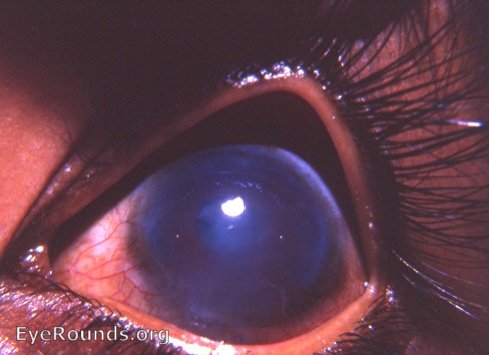Hydrophthalmos
Contributor: William Charles Caccamise, Sr, MD, Retired Clinical Professor of Ophthalmology, University of Rochester School of Medicine and Dentistry
*Dr. Caccamise has very generously shared his images of patients taken while operating during the "eye season" in rural India as well as those from his private practice during the 1960's and 1970's. Many of his images are significant for their historical perspective and for techniques and conditions seen in settings in undeveloped areas.
Category: Glaucoma / Iris
Since the Kurji Holy Family Hospital Eye Clinic attracted patients from far and wide including all of India and the Himalayan kingdoms, there was a daily flow of extreme and exotic eye pathology.
Congenital glaucoma was not a rarity in such a clinic population. Hydrophthalmos (hydrophthalmus) is primary congenital glaucoma. It is frequently a quiet disease. Enlargement of the cornea may be the first suggestion of the disease.This form of congenital glaucoma is usually bilateral. Some use the term buphthalmos/buphthalmus as synonymous with hydrophthalmos. Others prefer to use buphthalmos when the child manifests a secondary glaucoma as a result of some other intraocular disease.
In the photo, the young Indian boy has marked megalocornea/megalophthalmos from his primary congenital glaucoma, i.e. hydrophthalmos. In such patients, careful evaluation of the grossly normal appearing eye must be carried out.

Please see the close-up photograph of this patient's left eye. It demonstrates an enlarged cornea with a leucoma.

The differential is between megalocornea and hydrophthalmus. Corneal disturbances other than an increased corneal diameter may or not be present with hydrophthalmus. In hydrophthalmus there is an elevated intraocular pressure. In megalocornea, a corneal diameter over 13 mm is the positive finding.Since hydrophthalmus is usually bilateral, the smaller eye must be evaluated carefully for glaucoma.
Hydrophthalmos, right eye

The parents attributed the child's blindness in the right eye to a bout of dysentery. However, examination revealed an enlarged OD with hydrophthalmos.
Hydrophthalmos with gonotomy, left eye

Enlarged cornea, left eye, due to hydrophthalmos. Goniotomy was performed with successful result. Right eye being watched carefully for possible manifestation of glaucoma.

Hydrophthalmos, both eyes. Blind, both eyes

Hydrophthalmos is a primary congenital glaucoma that leads to enlargement of the eye as a result of increased pressure in a still-elastic young eye. Although the term buphthalmos is used synonymously with hydropthalmos, in India where there are so many cases of secondary glaucoma with marked enlargement of the cornea and eyeball itself, Dr. Caccamise would prefer to use buphthalmos for those cases of secondary glaucoma with eyeball/cornea enlargement in infants and young children.
Hydrophthalmos, both eyes with leukomatous cornea in one eye

Congenital primary glaucoma can result in an enlarged cornea simulating megalocornea. In megalocornea the eye is free of glaucoma.



Ophthalmic Atlas Images by EyeRounds.org, The University of Iowa are licensed under a Creative Commons Attribution-NonCommercial-NoDerivs 3.0 Unported License.


